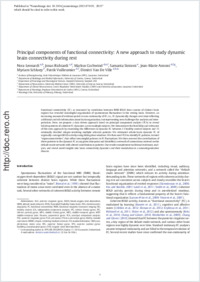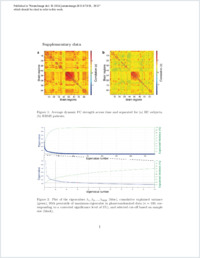Principal components of functional connectivity: a new approach to study dynamic brain connectivity during rest
- Leonardi, Nora Institute of Bioengineering, Ecole Polytechnique Fédérale de Lausanne (EPFL), Switzerland - Department of Radiology and Medical Informatics, University of Geneva, Switzerland
- Richiardi, Jonas Department of Neurology and Neurological Sciences, Stanford University, USA - Department of Neuroscience, University Medical Center (CMU), University of Geneva, Switzerland
- Gschwind, Markus Department of Neuroscience, University Medical Center (CMU), University of Geneva, Switzerland - Department of Clinical Neurosciences, Centre Hospitalier Universitaire Vaudois and University of Lausanne, Lausanne, Switzerland - Department of Neurology, Hopitaux Universitaires de Genève, Switzerland
- Simioni, Samanta Department of Clinical Neurosciences, Centre Hospitalier Universitaire Vaudois and University of Lausanne, Lausanne, Switzerland
- Annoni, Jean-Marie Department of Neuroscience, University Medical Center (CMU), University of Geneva, Switzerland - Department of Neurology, Hopitaux Universitaires de Genève, Switzerland - Neurology Unit, University of Fribourg, Switzerland
- Schluep, Myriam Department of Clinical Neurosciences, Centre Hospitalier Universitaire Vaudois and University of Lausanne, Lausanne, Switzerland
- Vuilleumier, Patrik Department of Neuroscience, University Medical Center (CMU), University of Geneva, Switzerland - Department of Neurology, Hopitaux Universitaires de Genève, Switzerland
- Ville, Dimitri Van De Institute of Bioengineering, Ecole Polytechnique Fédérale de Lausanne (EPFL), Switzerland - Department of Radiology and Medical Informatics, University of Geneva, Switzerland
-
2013
Published in:
- NeuroImage. - 2013, vol. 83, p. 937-950
English
Functional connectivity (FC) as measured by correlation between fMRI BOLD time courses of distinct brain regions has revealed meaningful organization of spontaneous fluctuations in the resting brain. However, an increasing amount of evidence points to non-stationarity of FC; i.e., FC dynamically changes over time reflecting additional and rich information about brain organization, but representing new challenges for analysis and interpretation. Here, we propose a data-driven approach based on principal component analysis (PCA) to reveal hidden patterns of coherent FC dynamics across multiple subjects. We demonstrate the feasibility and relevance of this new approach by examining the differences in dynamic FC between 13 healthy control subjects and 15 minimally disabled relapse-remitting multiple sclerosis patients. We estimated whole-brain dynamic FC of regionally-averaged BOLD activity using sliding time windows. We then used PCA to identify FC patterns, termed “eigenconnectivities”, that reflect meaningful patterns in FC fluctuations. We then assessed the contributions of these patterns to the dynamic FC at any given time point and identified a network of connections centered on the default-mode network with altered contribution in patients. Our results complement traditional stationary analyses, and reveal novel insights into brain connectivity dynamics and their modulation in a neurodegenerative disease.
- Faculty
- Faculté des sciences et de médecine
- Department
- Médecine 3ème année
- Language
-
- English
- Classification
- Biological sciences
- License
-
License undefined
- Identifiers
-
- RERO DOC 118038
- DOI 10.1016/j.neuroimage.2013.07.019
- Persistent URL
- https://folia.unifr.ch/unifr/documents/303003
Other files
Statistics
Document views: 115
File downloads:
- pdf: 389
- Supplementary material: 132

